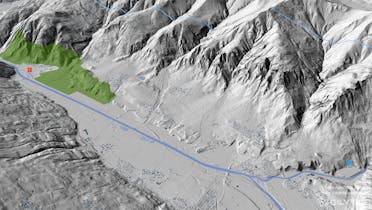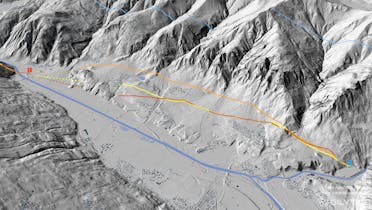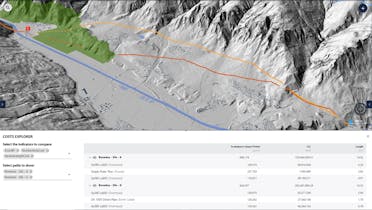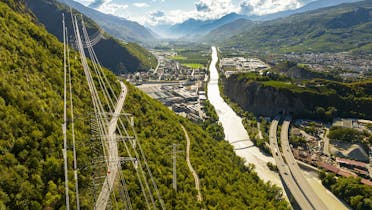
The quest for the Holy Grail, the mythical cup that contained the blood of Christ, inspired the Knights of the Round Table for centuries. Today, a similar quest, albeit in a different field, is driving Swissgrid employees – albeit in a different area: the search for a programme that can calculate the optimum routing of a line layout.
For several years now, a fruitful partnership has been developing between Swissgrid and the start-up Gilytics, a spin-off from the ETH Zurich to meet a major challenge in the Swiss energy sector.
Swissgrid, a key player in the Swiss energy landscape, is responsible for ensuring the reliable, efficient, and sustainable transmission of electricity throughout the country. This involves not only maintaining the existing grid, but also optimising and extending it by creating new lines.
Switzerland’s mountainous topography and population density make the creation of new lines particularly complex. There are numerous constraints: strict environmental standards, preservation of natural areas, distance from populated areas, high costs and wishes from the local population.
In the light of these challenges and the urgency of the energy transition, Gilytics has developed an innovative tool called «Pathfinder». Pathfinder can be used to rapidly identify the best corridors and routes for transmission line projects. It takes into account multiple factors such as the technical feasibility, costs, impact on residential and regional development, CO2 footprint and environmental assessments.
Its development required pioneering skills, a fighting spirit and unfailing determination. As this technological quest draws to a close, we met two of its knights, Robert Benz, Grid Program Manager, and Alain Appel, Grid Project Engineer, to find out more about this promising innovation.
Can you describe the mission entrusted to you and your team?
Our main objective is to find the best geographical corridors and routes for Swissgrid’s extra-high-voltage lines, taking into account multiple factors such as regional planning, the environment, economic efficiency and technology. Pathfinder, which was developed in association with Gilytics, speeds up and improves this process thanks to an advanced algorithm.
What are the capabilities of this new tool?
Pathfinder calculates possible routes between two or more substations, visualises them in 2D and 3D, and automatically calculates standardised financial and ecological costs. Reports and spatial data can easily be exported.
How does the tool work?
We’ve put together a collection of spatial data containing information about the nature of the landscape and its suitability for a corridor. An algorithm analyses this data to calculate the most suitable zones for a corridor or route. Even if the tool is not strictly speaking based on artificial intelligence, the way in which Pathfinder comes up with its results is fascinating. In simple terms, it combines a multitude of partial solutions to find the best options, which are then combined in turn. This model is based on concepts from Darwin’s theory of evolution, such as fitness, selection and evolution to find the most suitable solutions.
Even if the tool is not strictly speaking based on artificial intelligence, the way in which Pathfinder comes up with its results is fascinating.
What are the limits to using this tool?
Pathfinder doesn’t replace the work done by planners. Strategic, political and aesthetic decisions still need to be made by humans. The solutions suggested by the tool require critical examination, as the model remains a simplified representation of the real conditions on the ground.
Do you think this tool will improve your work going forward?
Yes, particularly in the current situation when so many projects need to be implemented and costs as well as ecological criteria must be calculated quickly. Pathfinder is extremely useful for processing quantitative criteria. This provides us with a solid foundation for our work without replacing it.
Why did you choose Gilytics and its Pathfinder invention rather than another tool?
Gilytics and Swissgrid have been working together for a long time. A public call for tenders was launched in 2023 for the actual acquisition with a view to using Pathfinder in our projects. Gilytics was the only supplier. Read our initial article about the tool, whose prototype name was 3D DSS, developed at ETH Zurich.
Has Pathfinder ever been used in practice?
Yes, we are already using it for corridor and route decisions. Recently, it not only validated a solution that had been developed by conventional means, but even came up with an alternative that we hadn’t envisaged.
Is there a specific pilot project where Pathfinder has already been used?
We are currently using Pathfinder to search for the ideal planning corridors at Bickigen – Mettlen, Flumenthal – Froloo and Bonaduz – Sils. The list of projects is constantly growing.
Have you managed to find your Holy Grail?
The term «Holy Grail» expresses how difficult it initially appeared to be to map several technologies (i.e. overhead lines and cable technologies) in the algorithm and to be able to show costs and life cycle assessments directly for all technologies. Like the coconut knights in the Monty Python comedy, we are already achieving results that impress with their precision and plausibility - and we can accept any stumbling blocks and obstacles with a dose of humour and then eliminate them.
What are the next steps?
All the functions required by Swissgrid had been implemented by the end of April 2024. The software will be fully operational in the projects from August. Until the end of August, the user-friendliness will be improved and the final functions refined.
This partnership between Swissgrid and Gilytics illustrates how technological innovation can help meet the complex challenges posed by energy infrastructure whilst respecting environmental and social constraints.
Let’s leave our valiant knights to continue their quest, but who knows, perhaps we’ll meet again soon at the Round Table to contemplate the famous Holy Grail!











